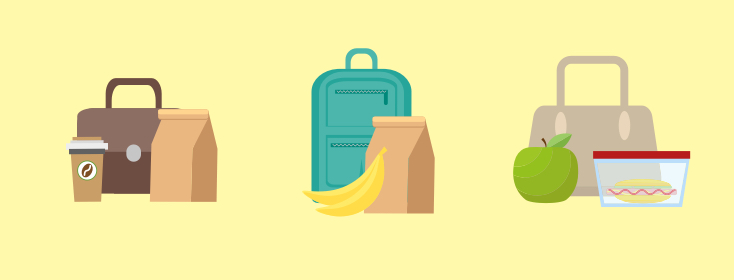How to Pack Lunch for Work
We all know that packing our own lunch for school or work saves us money that we would spend eating out and allows us to choose exactly what goes into our food. We don't have to wonder, look up, or ask if there are any added sugars or other carbohydrates that are not clearly visible in a meal. But did you know that there are benefits that go beyond lunchtime?
Meal Planning Skills
Packing your lunch helps you develop the skills of meal planning. You're deciding ahead of time what meal you're going to eat for lunch tomorrow and preparing it accordingly. You can use this same skill for breakfasts and dinners. Want chicken for dinner tomorrow? Prep the chicken the day before by cutting off the fat and covering it with herbs and spices in a glass container to marinate in the fridge. Or, cook it on your day off so that for the next couple of days, you'll have ready-made home-cooked chicken to heat up for dinner (or eat it cold in a sandwich or salad!). Type 2 diabetes is about planning.
Bulk Food Creativity
It helps you get creative with using the same food in different ways. Say you're preparing lunches and you open up a couple of cans of wild salmon and mix it with a little mayonnaise to have for lunch for the next couple of days, but you don't want to eat the same exact lunch two days in a row. What different ways could you pack the salmon to change it up?
Maybe you could have it on top of lettuce and tomatoes as a salad one day, and then have it in a couple of slices of whole-grain bread with sliced cucumbers the next. Again, this same skill can be used for breakfasts and dinners. Hard-boiled eggs are a great healthy food to prepare in bulk and find different ways to add them to meals throughout the week.
Develop Your Go-To Healthy Meals
Planning and packing your lunches helps you create a list of go-to meals that you know are good for you. Week after week as you decide what you want to have for lunch, you'll learn your favorites, and preparing them will become quicker and easier to where you don't even have to think about it.
Building a Healthy Habit
This is a huge benefit. Our habits determine our health. And we all know what to do – it's just about making it a habit. Because it'll be something you do each night or morning before work, packing your lunch will become integrated into your day, and you will have formed a habit.
It may sound daunting to think about starting to do something almost every day that you haven't done in the past but think about some of the things you already do every day. Brushing your teeth. Checking the mail. What's the first thing you do when you come home from work?
You do these things every day because they've become a habit. And if you forget to do it once, it's fine, and you pick back up again the next day and keep on going. Once the habit is formed, it's easy, but building it can take some extra thought and planning.
Make it easy on yourself – start with one day that you make and portion out your lunches for the next 2 or 3 days. On the other days, find healthy menu items at restaurants that can be your go-to when you eat out.
Get the Right Tools
Having the right types of lunch containers can make packing lunch easier.
- Plastic: These are the cheapest and most readily available. Instead of buying them, you can also reuse containers from items like deli meats, yogurt, or olive jars, but be careful because they may leak if the lid doesn't seal properly.
- Glass or Metal: These containers won't hold onto smells or flavors, but they're heavier than plastic. These will usually be safe for the dishwasher and microwave as well. Mason jars or empty pickle jars also make great containers for certain foods.
- Insulated: You can put hot foods (soup, stew) into these, and your food will still be hot by lunchtime; but you can't put these containers in the microwave.
Don't forget containers of all sizes! A container for your entrée or sandwich is essential, but smaller containers or jars for foods like sliced fruit, yogurt, nuts, or salad dressing will also help you pack a mighty mid-day meal that tastes great!
Don't forget the utensils! Cut down on plastic, and bring your own. Throw a metal fork in, or some containers come with reusable plastic utensils built right in. Chopsticks can also be useful for slowing down your eating pace, by forcing you to take smaller bites than with a fork or spoon.
An insulated lunch bag isn't just for kids! A lunch bag or cooler is a good investment to bring your healthy snacks/meals with you if you don't have a fridge accessible (or you're afraid a coworker may take your food!). You'll have more freedom to bring fresh items like fruit, yogurt, and sliced fresh veggies than with a regular old brown bag.
Don't forget inexpensive reusable ice packs! It might be a slight investment upfront, but you'll save money by not going out and by improving your management of your diabetes!
With type 2 diabetes, you want to spread out your carbohydrates between meals and snacks. If feasible, a larger lunchbox will allow you to have greater flexibility over the food you bring (i.e., you may prefer a larger lunchbox that also carries snacks over a lunch box that only holds a single food container). More space for fresh fruits, veggies, yogurt, nuts, and other healthy treats!

Join the conversation